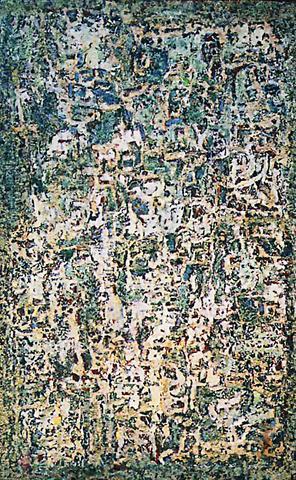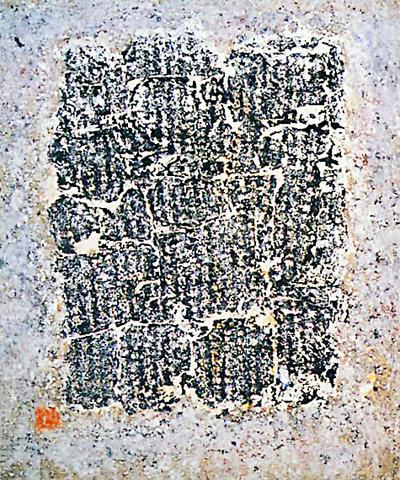When the 75-year-old George Chann held his solo exhibition, which proved to be his last, at a Los Angeles gallery in 1988, the local newspaper called him "a forgotten artist."
Indeed, Chann, the proprietor of Farmer's Market Art Gallery, who toiled a full eight hours every day at the easel in the back room of his shop for 40 years, hardly sold any work during his lifetime.
It was only after the Chinese ex-pat died in 1995 that his paintings slowly gained appreciation in the academic field and on the art market both here and abroad.

PHOTO COURTESY OF CITY GALLERY
After Chann's first posthumous exhibition, in Taipei in 2000, the life of the recluse began to unfold and his name started getting mentioned alongside those 20th century Chinese artists who were recognized much earlier, such as Sanyu (
In Chann's current exhibition, simply titled, "George Chann, Solo Exhibition" (
These Chinese calligraphy-incorporated abstract expressionist paintings are what Chann is most remembered for.

Chann started working in an abstract expressionist vein in the 1950s, when the school had become the mainstream of American modern art.
Although Chann once admitted in an interview to his admiration for abstract expressionist pioneers such as Mark Tobey and Jackson Pollock, he also realized that he had to explore different subjects and material if he was to develop his own style.
Chann did not have to look that far for inspiration, since his own art gallery -- not simply a display room for his own works, but a jewelry and Chinese artifacts shop -- had ample supply of calligraphy prints and rubbings taken from oracle bones, bronze vessels and steles.
According to art critic Wang Chia-chi's (
In many works, Chann made collages using these rearranged scripts on canvas. It was on these collages that the painter applied oil colors or, in some cases, wrote more calligraphy.
As if to create historical relics, Chann integrated fine sands on the painted surface to subtly imitate the time-worn veneer of artifacts.
These procedures resulted in some enchanting aspects to Chann's works.
While viewing an entire painting is enchanting, a closer look at the delicate traces of paint and the half-hidden elusive scripts, is as delightful as perusing a finely incised and naturally corroded Shang vessel. And in fact, the kind of azurite often found in the patina of Shang bronze is often an underlying color in Chann's paintings.
At the age of 12, Chann emigrated with his father from China's Guangdong province to California and was enrolled at the Otis Art Institute in Los Angles eight years later in 1934.
With a solid training in Impressionist techniques, Chann was an enthusiastic painter of the poverty of the blacks, Chinese and Mexicans, especially of the aged and orphaned among them.
Before Chann set up his art shop, he had good connections with several Los Angles dealers, and these works of social realism were frequently exhibited in his early years.
A less well-known line of painting Chann worked on involved scenes from the Bible. A Christian all his life, he donated 250 works to the Crystal Cathedral, near Los Angles, where they are now on permanent display.
George Chann Solo Exhibition runs until May 28 at Lin and Keng Gellery, No. 11, Lane 252, Tunhua S Rd., Sec 1 (

This month the government ordered a one-year block of Xiaohongshu (小紅書) or Rednote, a Chinese social media platform with more than 3 million users in Taiwan. The government pointed to widespread fraud activity on the platform, along with cybersecurity failures. Officials said that they had reached out to the company and asked it to change. However, they received no response. The pro-China parties, the Chinese Nationalist Party (KMT) and Taiwan People’s Party (TPP), immediately swung into action, denouncing the ban as an attack on free speech. This “free speech” claim was then echoed by the People’s Republic of China (PRC),

Exceptions to the rule are sometimes revealing. For a brief few years, there was an emerging ideological split between the Democratic Progressive Party (DPP) and Chinese Nationalist Party (KMT) that appeared to be pushing the DPP in a direction that would be considered more liberal, and the KMT more conservative. In the previous column, “The KMT-DPP’s bureaucrat-led developmental state” (Dec. 11, page 12), we examined how Taiwan’s democratic system developed, and how both the two main parties largely accepted a similar consensus on how Taiwan should be run domestically and did not split along the left-right lines more familiar in

Specialty sandwiches loaded with the contents of an entire charcuterie board, overflowing with sauces, creams and all manner of creative add-ons, is perhaps one of the biggest global food trends of this year. From London to New York, lines form down the block for mortadella, burrata, pistachio and more stuffed between slices of fresh sourdough, rye or focaccia. To try the trend in Taipei, Munchies Mafia is for sure the spot — could this be the best sandwich in town? Carlos from Spain and Sergio from Mexico opened this spot just seven months ago. The two met working in the

Many people in Taiwan first learned about universal basic income (UBI) — the idea that the government should provide regular, no-strings-attached payments to each citizen — in 2019. While seeking the Democratic nomination for the 2020 US presidential election, Andrew Yang, a politician of Taiwanese descent, said that, if elected, he’d institute a UBI of US$1,000 per month to “get the economic boot off of people’s throats, allowing them to lift their heads up, breathe, and get excited for the future.” His campaign petered out, but the concept of UBI hasn’t gone away. Throughout the industrialized world, there are fears that